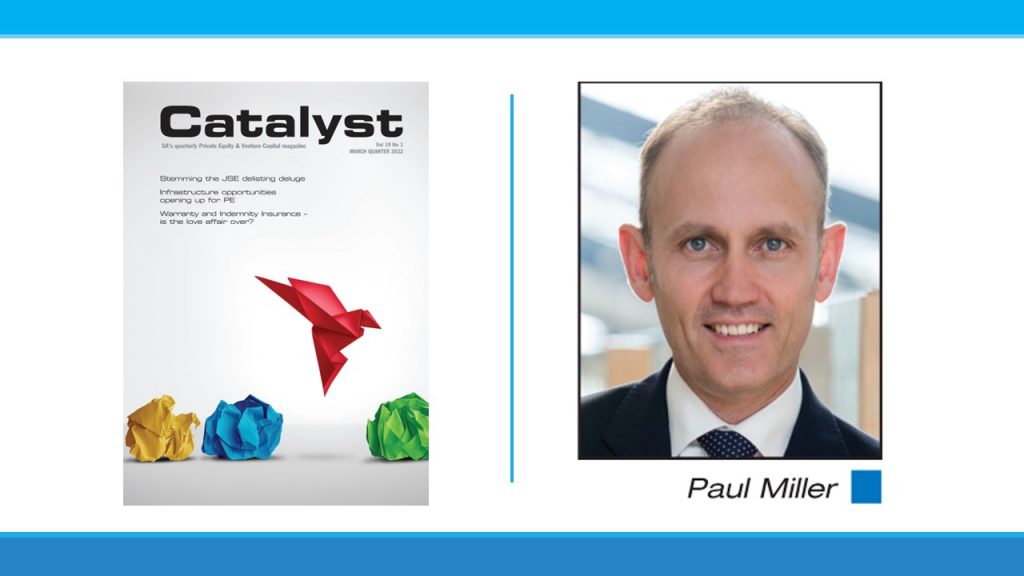South Africa’s public market is broken. In the past 30 years, the number of listed companies has more than halved from 760 to about 330.
Worryingly, the trend appears to be gaining momentum. No less than 25 delistings occurred in 2021 (with just seven new listings in the same period), and at least a further 21 delistings are already anticipated for 2022 – and we’re only at the beginning of the second quarter.
We must fix this situation and arrest this delisting trend. Everyone involved in investment banking needs to realise that this trend is a threat to their livelihoods. This is now a matter of urgency, because it is likely that the local public markets will enter something akin to a death spiral, where an ever-diminishing pool of very large listed companies is matched by an ever diminishing pool of ever larger asset managers, sucking the oxygen out of the market and stifling new entrants – both new listed companies and new investors.
Dynamic, lively public markets are required, not only to provide savings and investment opportunities, but also to underpin the growth and investment that is so desperately needed to support South Africa’s economic development and, of course, all-important job creation. It goes without saying that a public market in a death spiral will eventually also offer meagre opportunity to investment bankers.
While at a micro level, the JSE itself is an easy target for ascribing the blame for this crisis, the real structural cause has less to do with listing red tape, supposed high costs, or cyclical share prices, and everything to do with the systematic institutionalisation of the country’s savings and investment industry over the past three decades.
Investment on the JSE has become increasingly exclusionary.
Of course, the imperative to fix the delisting crisis in this country goes beyond providing investors with access to a diversity of investment options; the capital needs of the businesses themselves must be met by the public markets too. For the private investor in South Africa, opportunities to provide primary capital to newly listed companies have become increasingly few and far between. And the habit of companies and their advisors to structure listings to avoid the obscure JSE Listing Requirement 5.18 appears partly to blame.
Simply put, Requirement 5.18 states that if an offer of shares to the public is oversubscribed, the allocation of the available shares must be done equitably. It was created to ensure that when a general offer is made, like an initial public offering (IPO), large institutions don’t have an unfair advantage over smaller institutions, or the investor in the street. This is in line with the financial sector’s own charter to which all banks and many other advisors are party, and which has, as one of its objectives, the realisation of a more equitable financial sector – especially in terms of promoting the interests of those who have historically been excluded.
All of which begs the question: Why is Requirement 5.18 so obscure that the only people aware of its existence are regulatory managers studying towards their JSE sponsor executive exam?
The answer is that JSE Listing Requirement 5.18 has not been applied to any new listings for at least the past decade. It was last applied three times in 2010 and just once in 2012.
If the financial services sector deliberately excludes the public from most primary capital raising opportunities, largely for reasons only of timing and convenience, then they should not wonder why there is not a pool of smaller investors available to provide the oxygen that the market so desperately requires.
This exclusionary trend has also been driven by institutional investors who have what is known as an ‘acceptable limit’ on the size and liquidity of the companies targeted for investment by their asset managers – which generally translates to the largest 80 to 120 companies only. That’s not to say that those institutional investors are solely to blame, however, as it is the regulations within which they operate that are at the heart of the problem.
For example, a unit trust fund is typically required to return cash to an investor within 24 hours of receiving a request to withdraw funds. Delivering on this high liquidity expectation is a challenge for most funds. Not only is the minimum settlement period for disinvestment from a large liquid listed entity three business days, but selling out of a position in a smaller listed company can easily take as long as a week or two. This inherent liquidity mismatch exists in every collective investment scheme and is replicated across other types of institutional funds.
This size and liquidity bias means that the larger the fund gets, the fewer individual counters it can consider for investment. This compounds the death spiral as funds have been getting larger and, as a result, the number of counters in their acceptable investment universe has been shrinking.
The economics of personal stockbroking have also collapsed, and many stockbrokers have spent the last decade transforming into regulated wealth managers, which has involved moving most of their clients into index benchmarked model portfolios or institutionally managed collective investment schemes, with the remainder moved on to no-service, no-advice, secondary trading-only digital platforms.
Add to this the fact that an ever-increasing proportion of investing is now index-linked, and it is clear that South Africa’s financial sector has firmly turned away from both direct investment by smaller investors and investment into smaller listed entities.
It’s obvious that a massive bias in favour of ‘the large and the liquid’ has been designed into our entire institutional savings industry. That means that any company outside of the top 120 listed on the JSE receives very little interest from our institutional investors. The same institutional investors have, in turn, assimilated many small direct investors, in part through gatekeeping the access to tax incentives.
The solution: De-institutionalise our markets.
Irrespective of the answers to these questions, the reality we must face is that South Africa’s capital market is simply no longer fit for purpose, especially for a resource rich economy. This is clear when you compare the South African market to those in the UK, Canada and Australia.
As is the case in this country, individuals in those countries are given tax incentives to save. These range from tax deductions on pension contributions to deferment of capital gains tax in collective investment schemes. In South Africa, we have gone one step further and introduced tax free savings accounts that attract no tax at all.
The difference, however, is that South Africans are only able to access these tax incentives if they save in an institutional fund and pay an institution to manage the assets.
In contrast, UK, Australian and Canadian individual investors have the option of benefitting from these tax breaks through self-directed, self-invested or self-managed investment accounts, in which they can hold a wide range of assets, including stocks and shares.
By compelling South Africans to access these incentives only through institutions, we have choked off access to capital for smaller listed companies. Is it any wonder, then, that smaller companies don’t perceive any benefit to listing, or staying listed, on the JSE?
It is clear that any solution has to start with de-institutionalising our savings market. This demands a primary focus on the ‘bottom of the pyramid’, namely the general public. Meaningful incentives to save are needed, but in a way that gives individuals the right to choose where and how they save and invest. Most individuals will continue to save through institutions, but we must remove the monopoly that institutions currently enjoy on the access to tax incentives, if we are to save the very market on which they depend.
In 1992, the Jacobs Committee laid the basis for the next three decades of financial sector reform in South Africa. It proposed much of the legislative and regulatory scaffolding on which our savings industry now rests. Importantly, it investigated the ‘attainment of a level playing field for competing financial intermediaries (i.e. banks, life assurers and asset managers) in the country’. It did not, however, include consideration of the same levels of fairness for private direct investors and, as a result, it has inadvertently contributed to the steady shrinkage of the JSE that we have seen ever since.
The time has come for another Jacobs Committee, this time to investigate levelling the playing field between institutional and direct investors, with the objective that both should at least be afforded the same investment opportunities, be taxed on the same basis, and have the ability and incentive to support new listings of smaller companies seeking access to equity capital.
The time has come to de-institutionalise our stock exchange and get the investing public back into the public market. If we don’t, we may well end up with a bourse comprising only 120 or so large, liquid companies. And that will certainly be of no benefit to anyone.
Paul Miller is a Director of AmaranthCX.

This article first appeared in Catalyst, DealMakers’ private equity magazine.
DealMakers is SA’s M&A publication
www.dealmakerssouthafrica.com




A very well reasoned article. The JSE also need to look at the costs of listing and regulatory compliance as this no doubt prevents smaller companies from coming to the bourse.
An insightful article. As a (very) small direct investor on the JSE, I can only share the lament.
But there’s more:
1. The fashionable practice of “book building” in stead of a rights issue outright excludes the individual investor;
2. The avalanche of big (and some smaller) companies being sold to foreigners and then delisted: Edgars, SAB, Imperial, Mediclinic, Distell, AdaptIT, to name but a few.